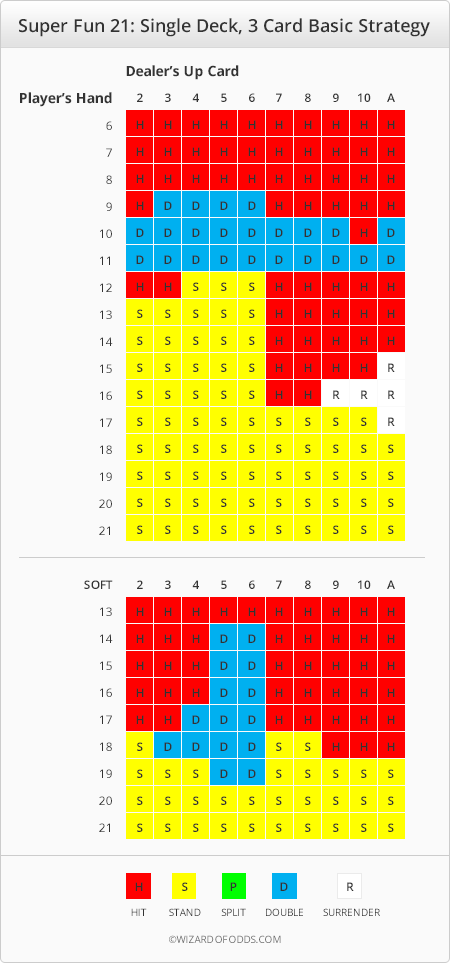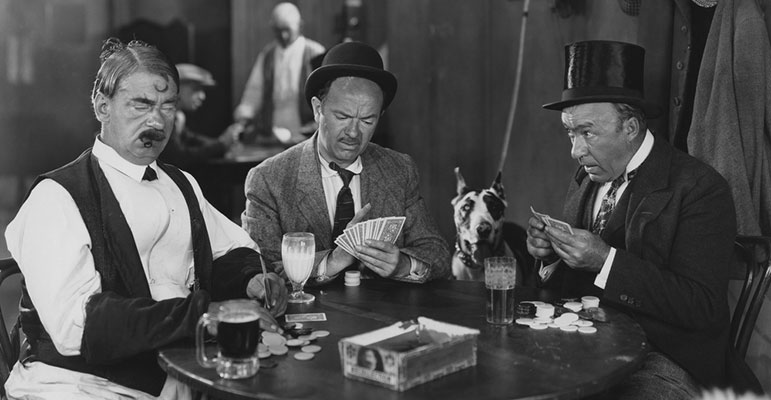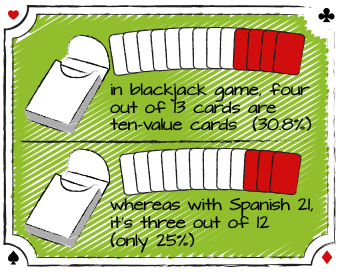Blackjack Spanish 21 Strategy
- Spanish 21 Tips
- Blackjack Spanish 21 Strategy For Beginners
- Blackjack Spanish 21 Strategy Chart
- Spanish 21 Card Counting
- Blackjack Spanish 21 Strategy Examples
- Blackjack Spanish 21 Strategy Tactics
Spanish 21 is a variation of blackjack with a lot of variant rules and payout differences. The biggest difference between Spanish 21 and other variations of blackjack is that it uses a “Spanish deck,” a deck of 52 cards where the 10s have been removed. Like in every blackjack variation, the main objective of players is to beat the dealer by getting closer to the total of 21, without going bust. In addition to the base game, however, on Spanish 21, players can make a side bet which will award special payouts to those who are lucky enough to win the additional bet.
Spanish 21 is my favorite blackjack game. It’s a trademarked variation owned by Masque Publishing in Colorado. You’ll find games that are eerily similar to Spanish 21 referred to as “Spanish blackjack.”
Spanish 21 has been popular in casinos for the last 20 years. One of the reasons for its popularity is its low house edge. Depending on the rules variations where you’re playing, the house edge for Spanish 21 is between 0.4% and 0.8%.
But that low house edge assumes that you’re playing with perfect basic strategy.
At this point, you’ve probably already read about blackjack and blackjack strategy. The rule differences between regular blackjack and Spanish 21 are enough that you’ll need to make a few adjustments to your basic strategy.
This post contains everything you need to know about the correct mathematical strategy for Spanish 21.
I’m not going to go into extreme detail about how to play Spanish 21, but I am going to provide the basics of how to play.
The biggest difference between Spanish 21 and regular blackjack is the deck. Spanish 21 uses a Spanish deck, which is a 48-card deck. It’s just like a standard deck of cards, but they’ve removed the 10s. (The jacks, queens, and kings are still in the deck.)
If you’ve read any of my posts about counting cards, you know that 10s are some of the most important cards in the deck.
To make up for the lack of 10s in the deck, Spanish 21 includes several additional rules that are favorable to the player.
Late surrender is allowed in Spanish 21, for example. This means that you can forfeit your hand and retain half your bet instead of having to risk the entire bet. “Late” surrender means that the option is available only after the dealer checks for blackjack.
You’re also allowed to double down after splitting, which has obvious advantages for the player. You’re also allowed to re-split aces, which is unusually permissive.
If you have a total of 21, you always win — regardless of what total the dealer has. Your blackjack will also always beat the dealer’s blackjack. (In regular blackjack, such a situation is treated as a push.)
You can also double down on any total. You can even surrender after doubling down, which is called “double down rescue.”
You also get bonus payouts for the following hands.
- A 5-card total of 21 pays off at 3 to 2
- A 6-card total of 21 pays off at 2 to 1
- A 7-card total of 21 (or more cards) pays off at 3 to 1
- 6-7-8 or 7-7-7 of different suits pays off at 3 to 2
- If that combination is suited, it pays off at 2 to 1
- If that combination is all of spades, it pays off at 3 to 1
- Suited 7-7-7 pays off a bonus of $1,000 if the dealer has a 7 showing or $5,000 if you bet $25 or more
These bonuses don’t count after doubling down, though.
You’ve probably seen blackjack basic strategy in the form of colored tables or charts. I don’t like to learn that way, so I don’t teach strategy that way, either. I just use plain old text.
Here’s a plain old text version of basic strategy for Spanish 21.
Hard Hands

A hard hand is a hand with no aces in it, or a hand where the ace must be counted as 1 to avoid busting. You’ll play hard hands less aggressively than soft hands because you have no wiggle room. A card that would bust a hard hand wouldn’t necessarily bust a soft hand.
You always stand with a hard total of 18 or higher.
You always hit a hard total of 8 or less.

For the other hard totals, here’s how you play the hand.
If you have a hard 9, double down on a two-card 9 if the dealer’s showing a 6. Otherwise, hit.
If you have a hard 10, double down if the dealer’s showing 2 through 7. Otherwise, hit.

If you have a hard 11, double down if the dealer’s showing 2 through 8. Otherwise, hit.
If you have a hard 12, always hit.
If you have a hard 13, hit if the dealer’s showing 2, 3, 4, or 7+. Stand if the dealer’s showing 5 or 6. If your 13 has five cards, hit against a dealer 5 or 6.
If you have a hard 14, hit if the dealer’s showing 2, 3, or 7+. You’ll also hit against a 4 if you have four cards or more totaling 14. And you’ll hit against a 5 or 6 if you have five cards or more.
If you have a hard 15, hit if the dealer’s showing 7+. Also hit if the dealer’s showing a 2 if you have four cards or more. And you’ll also hit against a 3 or 4 if you have five cards or more. Finally, you’ll also hit against a 5 or 6 if you have six cards.
If you have a hard 16, surrender if the dealer’s showing an ace. Hit against 7+. Hit against a 2 if you have five or more cards. And hit against a 3 or 4 if you have six cards.
If you have a hard 17, surrender if the dealer’s showing an ace. Otherwise, stand unless the dealer’s showing an 8, 9, or 10 AND you have six cards. If that’s the case, hit.
Soft hands are hands that include an ace which could be counted as 1 or as 11 without busting. You’ll play soft hands more aggressively because they’re harder to bust.
Spanish 21 Tips
Here’s how to play each specific soft hand.
Always stand on a soft 19 or higher.
Always hit a soft 15 or lower
Otherwise…
If you have a soft 16, double down if the dealer’s showing a 6, unless you have four cards or more. In that case, just hit. If the dealer’s showing any other card, just hit.
If you have a soft17, hit if the dealer’s showing 2 or 3 or 7+. Double down against a 4 if you have two cards, against a 5 if you have two or three cards, and against a 6 if you have two, three, or four cards.
If you have a soft18, hit if the dealer’s showing a 9, 10, or ace. Stand against a 2, 3, 7, or 8, with this exception — hit against 2, 3, or 8 if you have four cards or more. Also hit against 7 if you have six or more cards. Double down against 4, 5, or 6, with this exception — just hit against 4 if you have four cards or more, and hit against 5 or 6 if you have five cards or more.
Splitting Pairs
You’ll always split aces.
Never split 4s, 5s, or 10s.
Otherwise, follow the below strategy based on the pair that you have.
If you have a pair of 2s or 3s, split if the dealer’s showing a 3, 4, 5, 6, or 7.
If you have a pair of6s, split if the dealer’s showing 4, 5, or 6.
If you have a pair of7s, split if the dealer’s showing 2, 3, 4, 5, 6, or 7.
If you have a pair of8s, surrender if the dealer’s showing an ace. Otherwise, split, regardless of what the dealer’s showing.
Blackjack Spanish 21 Strategy For Beginners

If you have a pair of9s, split if the dealer’s showing 3, 4, 5, 6, 8, or 9.
In all these cases, if you’re not splitting, you should treat your total as if it were the corresponding hard total.
Spanish 21 is a great game and a nice change of pace if you’re used to playing just regular ol’ blackjack.
Blackjack Spanish 21 Strategy Chart
But there’s no reason to accept less than an optimal house edge. The basic strategy for Spanish 21 is easy enough to learn, but it has some subtleties that you don’t worry about in regular blackjack.
Spanish 21 Card Counting
This is mostly because of the bonus payouts based on the number of cards in your hand.
Blackjack Spanish 21 Strategy Examples
But with a house edge as low as 0.4%, Spanish 21 with basic strategy is one of the best bets in the casino.
Blackjack Spanish 21 Strategy Tactics
You can play Spanish 21 at many of the leading online casino sites.